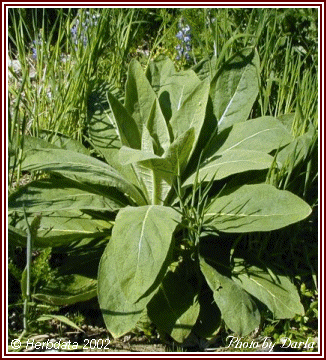
 Mullein
- Verbasci N.F. USD1926
Mullein
- Verbasci N.F. USD1926
compiled by Ivor Hughes.
VERBASCI FLORES. N. F. MULLEIN FLOWERS Verbose. Flor.
" Mullein Flowers consist of the dried corollas, with adhering stamens, of Verbascum phlomoides Linne, or of Verbascum thapsiforme Schraeder (Fam. Scrophulariaceae). Mullein Flowers contain not more than 2 per cent, of foreign organic matter. Flowers which have become brown should not be used." N. F.
Great Mullein; Mullein Dock; Flores Thapei barbati; Bouillon Blanc (Fleurs de), Molene, Fr., Flores Verbasci, P. G.; Wollkrautblumen, Koenigskenenbluiusn, G.
Off. Prep.� Species Pectorales, N. F.
VERBASCI FOLIA. N. F. MULLEIN LEAVES [Verbasc. FoL]
" Mullein Leaves are the dried leaves of Ver-bascum Ihapsus Linne (Fam. Scrophulariacece). Mullein Leaves contain not more than 2 per cent, of foreign organic matter and yields not more than 4 per cent, of acid-insoluble ash." N. F.
The mullein is a common weed native to Europe but abundantly naturalized in the United States, growing in open fields on stony hillsides. It is a tall, biennial herb reaching a height of 3 or 4 feet, terminating in a dense cylindrical spike of yellow flowers. The leaves are alternate and decurrent on the stem which is stout and simple. The whole plant is covered with a thick woolly pubescence. The corolla is rotate, almost regular and deeply five-lobed.
Folia Verbasci, Fr. Cod.; Feuilles de Bouillon Blano, Fr.; Wollkrautblatter, G.
Description and Physical Properties. The
flowers are described as follows: " Corolla light yellow, the outer surface grayish with a fine, soft, woolly indumentum, the inner surface sparsely hairy and finely veined; tube of the corolla 1 or 2 mm. in length and almost equally broad, the limb from 14 to 30 mm. in width, between wheel-shaped and saucer-shaped, obscurely two-lipped, the unequal lobes rounded, obovate. Stamens five, borne on the base of the corolla, shorter than the corolla, two of them longer than the other three, the filaments thick and fleshy, more or less pilose, especially the three shorter ones, usually orange-colored. Stamen-hairs cylindrical, unicellular, non-branching, surface minutely reticulate, apex rounded, frequently enlarged. Pollen grains smooth, triangular and more or less rounded, from 0.025 to 0.035 mm. in diameter. Odor peculiar, agreeable; taste mucilaginous, not agreeable.The flowers impart a yellow color to boiling water, and a rather permanent green color with dilute sulphuric acid, the latter color becoming brown upon the addition of alkalies. N. F.
The N. F. gives the following description of the leaves." Unground Mullein Leaves.�Obovate with narrowed base, or varying to oblong or oblong-lanceolate, without a true petiole, obtuse or tending toward acuteness at the summit, from 1 to 6 dm. in length and from 3 to 15 cm. in width; very thick, rather tough when damp, brittle when dry, light yellowish gray or greenish gray, densely long-tomentose, with numerous, multicellular, branching, non-glandular hairs. Nearly odorless; taste mucilaginous and slightly bitter.
"Powdered Mullein Leaves.� Dark green; numerous branching multicellular slightly ligni-fled hairs consisting of an upright, jointed central stalk with whorls of from 2 to 8 radiating lateral cells arising at the joints or apex, the lateral cells measuring up to 0.600 mm. in length; glandular hairs with a 1-celled stalk and a unicellular head, the latter from 0.020 to 0.030
mm. in diameter; numerous fragments consisting of epidermal cells with broadly elliptical stomata, the latter from 0,020 to 0.030 mm. in length and chlorenchyma associated with fibro-vascular tissue." N. F.According to Robert (Ph. Wb., 1918, Iv, p. 49), the V. Thapsus contains several saponins. According to L. Rosenthal (P. J., July, 1902), the seeds of Verbascum sinuatum L., which are used in Greece as a fish poison, contain 6.13 per cent, of a saponin. Traces of the same substance were found in the fruits of F. phlomoides L. and V. thapsiforme Schrad.
Uses.� Mullein leaves axe demulcent and emollient, and are thought to possess anodyne properties, which render them useful in pectoral complaints. On the continent of Europe, an infusion of the flowers, strained in order to separate the rough hairs, is considerably used in mild catarrhs. An oil, produced by saturating olive oil with mullein flowers, during prolonged exposure to the sun, is used as a local application in Germany for piles and other mucous membrane inflammations. The mullein oils sold in pharmacies are of this nature, or some of them alcoholic tinctures. The dried leaves are sometimes smoked to relieve irritation of the respiratory mucous membranes; fomentations with mullein leaves also have some repute as anodynes. Internally, the decoction (an ounce to the pint, flowering tips) may be taken in the quantity of from four to six fluid-ounces.
Dose, from one to two drachms (4 - 8 Gm.).
Off. Prep.� Fluidextractum Verbasci Foliorum, N. F.
Further information may be found by consulting the United States National Formulary in the site library or by using the search box at the top right of the page.
![]()